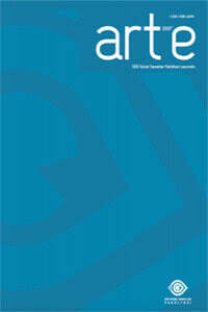SANAT VE TASARIMDA OPTİK İLLÜZYONA BAĞLI İMGE KULLANIM
Bu araştırma sanat ve tasarım alanlarındaki illüzyonist imgelerin kullanım biçimi üzerinekurgulanmıştır. Araştırmada gerçeküstü akımının sanatçılarından olan Salvador Dalininçalışmalarıyla, çağdaş grafik tasarımcısı Istvan Oroszun illüstrasyonları arasındaki illüzyonist imgelerkarşılaştırılmıştır. Her iki sanatçının imaj yaratma süreci, amacı ve yöntemi benzerlikler ve farklılıklarboyutunda bu araştırmada analiz edilmiştir. Dali sanat yapıtlarındaki obje, figür, manzara gibiunsurları kişisel boyutta değerlendirerek; illüzyonist, paranoyak-kritik ve rasyonel olmayan biryöntem ile resimlemiştir. Diğer taraftan Oroszun grafik illüstrasyonları bir tasarım probleminiçözmek için yapıldığından, elde edilen sonuçların algılanması ve tüketilmesi açısından Dalininçalışmalarından farklı bir zeminde görülmektedir. Bu sebeple, her iki sanatçı çalışmalarında illüzyonve çift imaj yaklaşımlarını kullanmıştır. Dolayısıyla sanatçıların imgelerinde paralel benzerliklerolduğu söylemek mümkündür. Bu paralel benzerliklere rağmen, Dalinin çalışmaları kavram veyorumlama yönüyle bir çok farklı manalar oluşturmaktadır. Oroszun illüstrasyonları ise spesifik birkonu etrafında yorumlanabildiği için, anlaşılması ve algılanması daha kolay ve çabuk olmuştur.
USAGE OF OPTICAL ILLUSION IMAGE IN ART AND DESIGN
This research is based on how illusionist images are used between art and design disciplines.I compared the works of Salvador Dali, Surrealist artist, and illustrations of Istvan Orosz,contemporary graphic designer, in this research. Both of the artist s image creation process has beenanalyzed through aim, method, similarity and differences. Dali evaluated objects, figures andlandscapes with his own experiences in which he painted these facts with illusion, paranoiac-criticand irrationality. On the other hand, because of Orosz s illustrations were made to solve designproblems, the results of this approach has different ground than Dali s artworks. Therefore, both ofthese artists use Illusion and double images approaches in their works. Thus, it is possible to saythat there are parallel connections in the artworks of these artists.Despite these similarities and parallel connections, Dali s works, in terms of concepts and meanings,cause the numbers of possible of interpretations. On the other hands, Orosz works are more easyand quick to grasp and detected, because of his works were made for a specific purpose
___
- Ades, D., (2000). Dalis Optical Illusions, Yale University Press, Connecticut. Ades, D. and Taylor, M., (2004). Dali, Rizzoli, New York. Block, R., (2000). Seeing Double, Routledge, NY. Breton, A., (1965). Surrealism and Painting, Macdonald Publishing, London. Champignealle, B., (1973). Graphis, Volume, 7, No:34, Zürich. Crowley, D., (1993). Losy Art, Creative Review Magazine, October, London. Descharnes, R., (1985). Salvador Dali, Harry N. Abrams, Inc., Publishers, New York. Foster, H., (1995). Compulsive Beauty, Cambridge, MIT Press, MA. Fukuda, S., (1993). İstvan Oroszs Visual Tricks, Idea Magazine, No:239, Tokyo. Füresz, A., (1994). İstvan Orosz, Balassi Kiado, Budapest. Gaillewin, J., (1995). Dali: Master of Fantasies, Harry N. Abrams, Inc, Publisher, New York. Gerard, M., (1974). Dali, Dali, Dali, Harry N. Abrams, Inc, Publisher, New York. Haiman, G., (1994). Winning the Eye, Print Magazine, Vol. 48, No. 1, New York. Hugnet, G., (1947). Fantastic Art, Dada, Surrealism, Alfred H. Barr, Jr. (ed.), New York. Kner, A., (2000). Istvan Orosz, Nyomdai Kivitelezes, Budapest. Lord, R., (2000). Istvan Orosz, Nyomdai Kivitelezes, Budapest. Maddox, C., (1979). Dali, Crown Publishers, Inc, New York. Marcel, J., (1960). The History Of Surrealist Painting, Grove Press, Inç, New York. Martin, R., (1990). Fashion and Surrealism, Rizzoli, New York. Montagu, J., (2002). The Surrealist:Revolution in Art And Writing, 1919-35, Tate Publishing, London. Moore, M., (2000). Istvan Orosz, Nyomdai Kıvıtelezes, Budapest. Moorhouse, P., (2001). Dali, PRC Publication Ltd., London. OPray, M., (1987). A Svankmayer Inventory Afterimage, Sayı:13. London. OPray, M., (1995). Jan Svanmajer: A Mannerist Surrealist Dark Alchemy: The Films of Jan Svankmajer, by Peter Hames (ed.), Westport. Schalttshneider, D., (2000). Istvan Orosz, Nyomdai Kıvıtelezes, Budapest. Schneede, U. M., (1973) Surrealism. The Movement and Masters, Harry N. Abrams, Inc, Publishers. New York. Seckel, A., (2004). Masters of Deception: Escher, Dalı and the Artist of Optical Illusion, Sterling Publication Co., NY. Todovic, Zoran., (2010). World Posters, http://www.studentbiennialns.com/2010/jury 2010.html Wolfram, A., (1975). History of Collage, Studio Vista, London.
- Yayın Aralığı: Yılda 2 Sayı
- Başlangıç: 2008
- Yayıncı: Süleyman Demirel Üniversitesi Güzel Sanatlar Fakültesi
Sayıdaki Diğer Makaleler
Bitlis Etnografya Müzesi'nde Bulunan Geleneksel Giysiler
AMBLEM ve LOGO TASARIMLARINDA RENKLERİN DİLİ
BREZİLYA'DA GELENEKSEL ÇÖMLEKÇİLİK SANATI VE FLORİANOPOLİS ÖRNEKLERİ
Sibel Sıdıka SEVİM, Ezgi MARTİNEZ VERDU HAKAN, Cemalettin SEVİM
Cumhuriyet Dönemi Türk Resiminde Mimaride Bayrak İmgesi
SANAT VE TASARIMDA OPTİK İLLÜZYONA BAĞLI İMGE KULLANIM
GELENEKSEL VE KÜLTÜREL UNSURLARIN POSTMODERNİZM İLE BİRLİKTE TEKSTİL TASARIMINDA YÜKSELİŞİ
Ahmet AYTAÇ, Banu Hatice GÜRCÜM
GRAFİK TASARIMDA YENİ NESİL FONT TASARIMI
OPLUMSAL FARKINDALIK İÇİN GRAFİK TASARIM
Sanat ve Tasarımda İllüzyonist İmgenin Kullanımı
